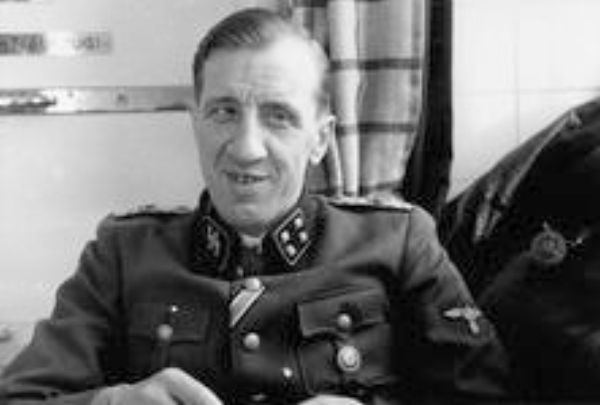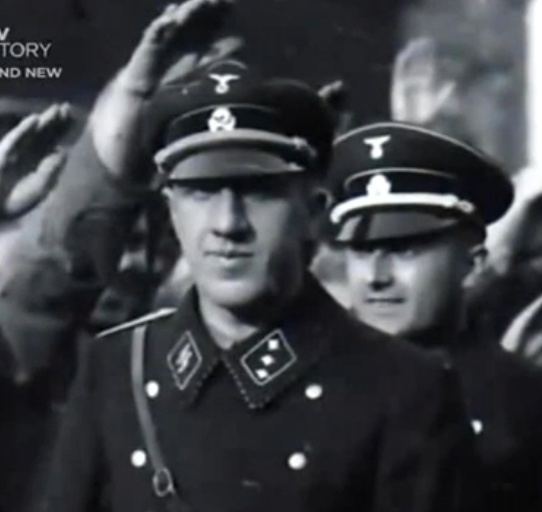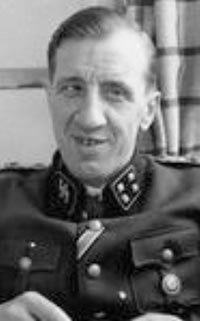Rank Obersturmbannfuhrer** Battles and wars World War II | Name Bruno Gesche Battles/wars World War II | |
 | ||
Unit SS-Begleitkommando des Fuhrers, 5th SS Panzer Division Wiking, 16th SS Panzergrenadier Division Reichsfuhrer-SS Similar Sepp Dietrich, Kurt Gildisch, Franz Schädle | ||
SS-Obersturmbannführer** Bruno Gesche (5 November 1905 – 1980) was a lieutenant colonel of the SS in Nazi Germany. He was a member of Adolf Hitler's entourage and the fourth commander of Hitler 's personal bodyguard (originally known as the SS-Begleitkommando des Führers, later known as Führerbegleitkommando) for the periods June 1934 – April 1942 and December 1942 – December 1944.
Contents
- Early career
- SS Begleitkommando des Fhrers
- Conflicts with Himmler
- War years
- Promotions demotions and decorations
- References

Early career

Gesche's aspirations for a career in the German military as an officer were effectively ended by the limitations imposed by the Treaty of Versailles on the post-First World War national defence force, the Reichswehr and his limited education. Gesche joined what was then a fringe political movement, the NSDAP (Nazi Party), and its paramilitary wing, the Sturmabteilung (SA) in 1922. Although Gesche's association with the Nazi movement cost him his job at a bank in 1923. His status within the Nazi Party as an Alte Kämpfer (NSDAP Member No. 8592) proved to be a tremendous asset to him during the better part of the subsequent two and a half decades. In 1927 Gesche left the SA to join what was then its subordinate outfit, the Schutzstaffel (SS Member No. 1093). The SS, as in its earlier incarnations, the Stabswache and Stoßtrupp-Hitler, functioned as the future Führer's bodyguard.
SS-Begleitkommando des Führers

On 29 February 1932, with the advice of Reichsführer-SS Heinrich Himmler, Hitler chose eight from a prospective twelve SS men presented by Sepp Dietrich, to serve as his personal bodyguard, the SS-Begleitkommando des Führers. One of the handpicked men was Bruno Gesche. Not long after the unit's creation, Gesche managed to draw the ire of Himmler To Himmler's consternation, Hitler's fondness for Gesche stemming from their days as old guard comrades would define Gesche's fate for practically the duration of Nazi Germany.
Conflicts with Himmler

The first incident between Gesche and Himmler arose as a result of criticism that the former levied against the security detail provided by another SS unit during a Hitler campaign speech in Selb on 14 October 1932. Himmler regarded this as a personal affront. Both Himmler and the SS Group Commander South demanded that Gesche be demoted and removed from the SS-Begleitkommando, however, Hitler ordered that Gesche receive only a reprimand.
Himmler did succeed in having Gesche's immediate superior, the third commander of the SS-Begleitkommando, Kurt Gildisch dismissed in 1934. Eventually Gildisch was dismissed from the SS, as well as the Nazi Party in 1936, for repeated instances of drunkenness. Gesche as second-in-command succeeded Gildisch as commander of the SS-Begleitkommando in June 1934. The unit was later expanded and became known as the Führerbegleitkommando (Führer Escort Command; FBK).
On another occasion in 1935, Himmler as part of his attempts at consolidating his authority ordered that salaries of Hitler's personal bodyguard detail be suspended. Gesche responded by enlisting the help of the commander of Hitler's personal bodyguard regiment, Leibstandarte SS Adolf Hitler, Sepp Dietrich, who was able to have Himmler's order reversed.
Seizing on Gesche's frequent bouts of intoxication, Himmler enforced an SS requirement that had been established in 1937, forbidding SS men from consuming alcohol in excess of certain mandated limits. After obtaining evidence that Gesche was in violation of the mandate, Himmler had him sign a statement on 26 September 1938, promising to abstain from alcohol consumption for three years or else face expulsion from the SS. After a few months Himmler lifted the ban. Hitler's fondness for Gesche had again forced Himmler's hand.
War years
In early 1942, after another session of heavy-drinking, Gesche pulled his pistol and threatened a fellow SS officer. After Himmler was informed of the events, even Gesche's close relationship with Hitler could not save him from the wrath of the Reichsführer-SS. Gesche was dismissed from his command of the Führerbegleitkommando and again required to abstain from drinking for three years. Gesche was transferred to the Eastern Front and the Waffen-SS, 5th SS Panzer Division Wiking. He served with 1./SS-Panzer-Jäger-Abteilung 5. The 5th SS, from the moment Gesche arrived in the summer of 1942, engaged in bitter battles with Soviet forces for control of the oil-rich Caucasus. Before the collapse of the German 6th Army at Stalingrad, and the retreat through the Caucasus by the remnants that had not surrendered Gesche had been evacuated from the front after being wounded in combat. Hitler was very pleased with Gesche's performance, and by December 1942, he returned to command the Führerbegleitkommando. Hitler decreed that no man who had served in Hitler's HQ should be sent to the Eastern Front, for fear of capture and interrogation by the Soviets as to security information.
In December 1944 Gesche's time as commander of the Führerbegleitkommando came to an end. In his strongly worded rebuke, soon after an incident that featured a drunken Gesche firing shots at a comrade, Himmler wrote in part:
After Gesche was reduced by nine grades, from a SS-Obersturmbannführer to SS-Unterscharführer, Franz Schädle was promoted to be the next commander of the FBK. Gesche's assignment to the notorious SS penal unit, Dirlewanger, at that stage of the war, was for all practical purposes a death sentence. Although Hitler did not personally intervene on Gesche's behalf, other allies in the SS did. SS-Gruppenführer Hermann Fegelein and SS-Obergruppenführer Maximilian von Herff successfully argued that assignment to the Dirlewanger Brigade which was then operating on the Eastern Front, would be in contravention to the Hitler order forbidding such deployments. Although Gesche was spared certain death with the Dirlewanger unit, he never again rejoined the Führerbegleitkommando. He was instead assigned to the 16th SS Panzergrenadier Division Reichsführer-SS, 5./SS-Panzer-Grenadier-Regiment 35, ultimately surrendering to the Americans in Italy in 1945. According to records housed at the Deutsche Dienststelle (WASt), Bruno Gesche's last date of internment by the Western Allies was 22 March 1947.
